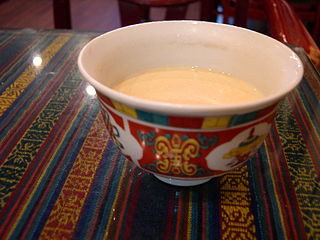
Butter tea, also known as po cha, cha süma, Mandarin Chinese: sūyóu chá (酥油茶) or gur gur in the Ladakhi language, is a drink of the people in the Himalayan regions of Nepal, Bhutan, India and China.

Thukpa is a Tibetan noodle soup, which originated in the eastern part of Tibet. Amdo thukpa is a famous variant among Tibetan people and himalayan people of Nepal. The dish became popular in various parts of Nepal, Bhutan, and the states of Sikkim, Assam, Nagaland and Arunachal Pradesh in northeast India. It is also popular in the Ladakh region and the state of Himachal Pradesh. The food is widely available in these regions. The numerous varieties of thukpa in Tibetan tradition include:

Tibetan cheese is a food staple in Tibetan cuisine. Tibetan cheeses include soft cheese curds resembling cottage cheese made from buttermilk called chura loenpa. Hard cheese is called chura kampo. Extra hard cheese, made from solidified yogurt, is called chhurpi, and is also found in Sikkim and Nepal. Another type of cheese called shosha or churul, with a flavor said to resemble Limburger, is made from cream and the skin of milk.
Balep korkun is a type of bread that is consumed mainly in central Tibet. It is round, flat and relatively easy to make. The ingredients are tsampa, water and baking powder. It is cooked in a frying pan. It has been described as similar in appearance to naan.
In Tibetan cuisine, Lunggoi Katsa is stewed sheep's head, with curry, fennel, monosodium glutamate and salt.
In Tibetan cuisine, Tu is a cheese cake, made with yak butter, brown sugar and water, made into a pastry.
In Tibetan cuisine, Masen is a pastry, made with tsampa, dry cubic or curd cheese, yak butter, brown sugar and water.
In Tibetan cuisine, Gyabrag is a pancake, made with barley flour, yak butter, dry cheese curds and sugar.
In Tibetan cuisine, Yurla is a wheat pastry with butter, particularly common in Nyainrong County in northern Tibet.
In Tibetan cuisine, Zhoixo is wild ginseng, made with yogurt.
In Tibetan cuisine, Xabbatog is a dough stuffed with shredded turnips and dry curd cheese and cooked with bone soup.
In Tibetan cuisine, Xab Momo is a bun, usually baked or steamed, stuffed with beef or mutton.
In Tibetan cuisine, gundain is a type of pastry made from barley grain and yeast, with tsampa, dry curd cheese, wild ginseng, and brown sugar. This pastry is often served during the Tibetan New Year and Losar as a starter.
Gyurma is a blood sausage made with yak or sheep's blood in Tibetan cuisine. Rice or roasted barley flour can be added as filler. The sausage uses natural yak or sheep casing (intestine).

Shabhaley, also known as sha phaley, is a Tibetan dish of bread stuffed with seasoned beef and cabbage, which is then fashioned into semi-circular or circular shapes and which according to regional variations is either deep fried or pan fried like pot stickers.
Khapsey are cookies or biscuits in Tibetan cuisine that are deep fried and usually made during celebrations such as the Losar or weddings. Khapseys are fashioned into many different intricate shapes and textures. Some are sprinkled with powdered sugar, while other shapes, such as the donkey ear-shaped khapseys, decorative.

Laping is a spicy cold mung bean noodle dish in Tibetan cuisine. It is a street food. It can be eaten with red pepper chili, cilantro and green onion sauce. The noodles have a slippery texture and are served with a soy sauce gravy. It is traditionally a summer food. A tool is used to shape it.
Thue is a delicacy in Tibetan cuisine made with dri cheese, brown sugar and unsalted sweet cream butter. These ingredients are mixed together by hand into a smooth, slightly crumbly doughy mixture. It has a high butter content and is shaped in a thuedrom, a rectangular wooden frame about the size of a small brick. Thue is often topped with representations of the moon and the sun, carved out of butter while it is in a cold state. It is one of the few sweet Tibetan dishes and is eaten as a dessert on Losar and other special occasions like the Sho Dun Festival or on weddings.

Galdan Namchot is a festival celebrated in Tibet, Mongolia and many regions of Himalaya and particularly in Ladakh, India. It is to commemorate the birth as well as parinirvana (death) and the Buddhahood of Je Tsongkhapa, a famous Scholar/teacher of Tibetan Buddhism whose activities led to the formation of the Gelug school of Tibetan Buddhism. Galdan Namchot also marks the beginning of the new year celebrations in Ladakh.






